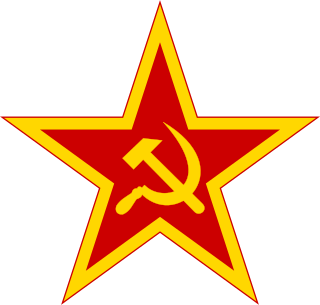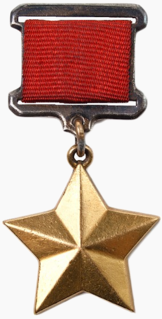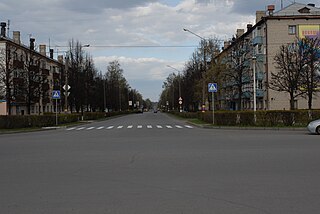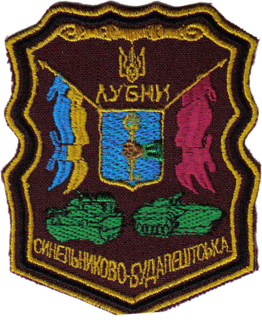Alexander Dmitrivich Vologin was a Soviet soldier who was awarded the title of Hero of the Soviet Union posthumously on January 15, 1944, for his actions during Operation Kutuzov and the Battle of the Dnieper. He was killed on October 17, during the Battle of the Dnieper in modern-day Belarus.
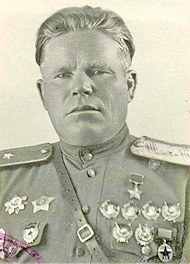
Ivan Nikitich Konev was a Soviet major general during World War II and a Hero of the Soviet Union. Konev led the 3rd Guards Airborne Division through most of the war and was awarded the title Hero of the Soviet Union for his leadership of the division during the Jassy–Kishinev Offensive. Postwar, Konev continued to serve in the Soviet Army and became the deputy commander of multiple army corps.

Alexander Andreyevich Kolesov was a Soviet officer and Hero of the Soviet Union. Kolesov was awarded the title for his actions during the Battle of the Dnieper. Due the wounds he suffered during the fighting, Kolesov was not able to hold another combat post during the war. However, he returned to the Army postwar and eventually retired as a colonel. He later worked as a quality controller within the Soviet military equipment procurement organization.

Selim Aitkulov was a Tatar soldier of the Red Army and Hero of the Soviet Union. Aitkulov was awarded the title Hero of the Soviet Union and the Order of Lenin for actions during the Battle of the Dnieper, in which he took command of his platoon after his platoon commander was wounded. After the war, Aitkulov was the head of the Uralsk Regional Consumer Union's Organization Department.

Sergey Andreyevich Mostovoy was a Red Army man and Hero of the Soviet Union. Mostovoy was awarded the title Hero of the Soviet Union and the Order of Lenin for his actions during the Vistula–Oder Offensive.
Viktor Andreyevich Turbin was a Red Army Junior Lieutenant and posthumous Hero of the Soviet Union. Turbin was posthumously awarded the title Hero of the Soviet Union and the Order of Lenin for his actions while leading a platoon during Operation Bagration in summer 1944. His platoon reportedly held a bridgehead on the Drut River against numerically superior German troops until the crossing of the remainder of Turbin's regiment.
Arkady Yegorovich Chepelev was a Red Army Starshina or sergeant major and Hero of the Soviet Union. He was awarded the title for ferrying weapons and ammunition to troops in the Dnieper bridgehead and repelling counterattacks during the Battle of the Dnieper. Chepelev continued to fight in combat and served with the 167th Rifle Division during the Lvov–Sandomierz Offensive and Battle of the Dukla Pass, among others. He was demobilized postwar and returned to Voronezh, working as a mechanic in an aircraft factory.

Dmitry Ivanovich Rodin was a Red Army junior lieutenant and Hero of the Soviet Union. Rodin was awarded the title for his leadership of a platoon during the Lublin–Brest Offensive, during which he was seriously wounded for the sixth time. As a result of this, Rodin spent the rest of the war in the hospital and was discharged in April 1945. Postwar, he worked as an engineer in the Ministry of Railways design and research institute.

Ivan Dmitrievich Burmakov was a Soviet Army lieutenant general and Hero of the Soviet Union. Born in 1899 to a Ukrainian peasant family, he joined the Red Army in 1918. He fought in the Russian Civil War and the Polish–Soviet War. After graduating from the Red Commanders School, he became an officer. Burmakov rose through the ranks during the interwar period and in August 1942 became commander of the 38th Motor Rifle Brigade and fought in the Battle of Stalingrad. At the end of the battle, his troops captured 6th Army commander Friedrich Paulus. For its actions the brigade became the 7th Guards Motor Rifle Brigade. Burmakov was sent to the Military Academy of the General Staff and graduated in May 1944. He became commander of the 31st Guards Rifle Division in July 1944. Burmakov led the division in Operation Bagration, the Gumbinnen Operation, the East Prussian Offensive and the Battle of Königsberg. For his leadership, he was awarded the title Hero of the Soviet Union on 19 April 1945. Postwar, Burmakov continued to serve in the Soviet Army, leading the 29th and 21st Guards Mechanized Divisions and the 52nd Rifle Corps. After retiring in 1955, he lived in Odessa and died in 1973.
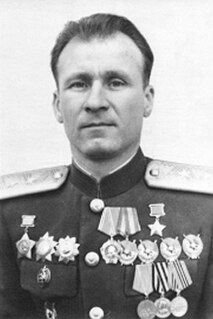
Andrey Matveyevich Andreyev was a Soviet Army Colonel general and Hero of the Soviet Union. Andreyev joined the Soviet Border Troops in 1924 and became an officer. After graduating from the Frunze Military Academy, he was given command of a border detachment. Andreyev fought in the Winter War as commander of a ski regiment of the border troops. After spending the first months of World War II as logistics chief of the 23rd Army, he was appointed to command the 43rd Rifle Division in September. In late October he took command of the 86th Rifle Division, fighting in the Nevsky Pyatachok. In April 1942 Andreyev became deputy commander of the 23rd Army and then the 42nd Army in May. He became commander of a special group in the 42nd Army's Staro-Panovo Offensive, in which he was wounded.
Grigory Samoylovich Kabakov was a Ukrainian Red Army lieutenant and Hero of the Soviet Union. Kabakov was awarded the title for leading his company during the Battle of the Dnieper in September 1943, where he reportedly killed 60 German soldiers.
Dmitry Timofeyevich Kamolikov was a Red Army sergeant and a Hero of the Soviet Union. Kamolikov was awarded the title for his actions in the Budapest Offensive during the crossing of the Tisza, when he reportedly led the repulsion of 12 counterattacks. He was seriously wounded in the battle and was discharged. Postwar he worked as an engineer at a factory equipment supply factory.
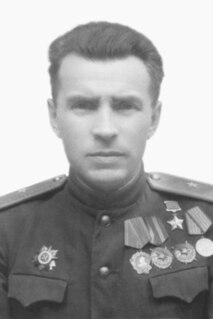
Leonid Alexandrovich Kolobov was a Soviet Army Lieutenant general and Hero of the Soviet Union. After being drafted into the Red Army in 1928, Kolobov graduated from the Moscow Infantry School and became an officer. In 1940 he became chief of staff of a Finnish People's Army infantry division. In September 1941, Kolobov became chief of staff of the 408th Rifle Division in Iran. From September 1942 he commanded the 389th Rifle Division. He led the division until the end of the war, being awarded the title Hero of the Soviet Union for his leadership in the Lvov–Sandomierz Offensive. Postwar, he led the 97th Guards Rifle Division, 114th Guards Airborne Division, 86th Guards Rifle Division and 4th Guards Army Corps. Kolobov also served as an adviser in East Germany during the 1950s. He retired in 1969, lived in Moscow and died in 1993.
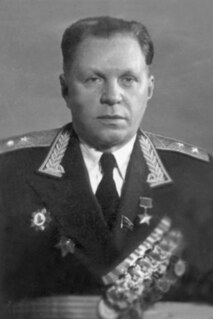
Daniil Vasilievich Kazakevich was a Belorussian Soviet Lieutenant general and Hero of the Soviet Union. Kazakevich was drafted into the Red Army in 1920 and fought in the Polish–Soviet War. In 1923 he transferred to the Soviet Border Troops. Kazakevich became an officer and by 1939 was chief of staff of a border district in the Soviet Far East. In December 1942 he became chief of staff of the Far Eastern NKVD Rifle Division, which became the 102nd Rifle Division some months later. After fighting in Operation Kutuzov, Kazakevich was given command of the 399th Rifle Division in September 1943. Kazakevich led the division through the Battle of the Dnieper, Operation Bagration and the East Prussian Offensive. He was awarded the title Hero of the Soviet Union for his leadership in the battle for the Narew bridgeheads during September 1944. Postwar, Kazakevich returned to the Border Troops and led the Moldovan and Southwestern Border Districts. After a two-year period as an advisor to the East German Border Troops, Kazakevich became chief of the Border Troops military educational institutions. He retired in 1959 and lived in Moscow, working in the Intourist Directorate.

Ochil Kadyrov was an Uzbek Red Army soldier and a posthumous Hero of the Soviet Union. Kadyrov was posthumously awarded the title for reportedly using his machine gun to enable the crossing of the Narew by his regiment in September 1944. He was seriously wounded and died of his wounds on 13 March 1945.
Nikolai Panteleyevich Kabak was a Red Army sergeant and Hero of the Soviet Union. He was awarded the title for reportedly ferrying troops and equipment during the Battle of the Dnieper in October 1943. Postwar, Kabak was chairman of the local village council and worked for a brick factory and a shipping company.
Nikolai Petrovich Kabalin was a Red Army starshina or sergeant major and Hero of the Soviet Union. Kabalin was awarded the title for his actions during the Dnieper–Carpathian Offensive. Kabalin reportedly destroyed a German machine gun, enabling his battalion to establish a bridgehead. In early May 1944 he was seriously wounded when a bomb hit his dugout and was later discharged for medical reasons. Postwar, he worked at the Gorky automobile plant.
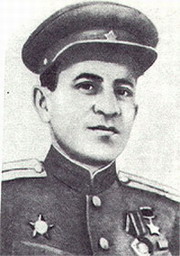
Mammad Ali oglu Maharramov was an Azerbaijani Red Army lieutenant and a Hero of the Soviet Union. Maharramov fought in the Winter War after being drafted into the Red Army in 1941. He fought in World War II from 1941 and was awarded the title Hero of the Soviet Union on 22 February 1944 for leading his squad in reportedly killing 50 German soldiers during the Battle of the Dnieper, among other actions. After the war, Maharramov was chairman of the village council and a kolkhoz.

Mikayil Mahammad oglu Alakbarov was an Azerbaijani Red Army man and a posthumous Hero of the Soviet Union. Alakbarov was posthumously awarded the title on 26 October 1943 for his actions during the Battle of the Dnieper, during which he reportedly repulsed 14 counterattacks and was seriously wounded.
Nikolai Alexeyevich Vychuzhanin was a Red Army junior lieutenant and a Hero of the Soviet Union. Vychuzhanin was awarded the title on 15 January 1944 for his actions in crossing the Dnieper in eastern Belarus, in which he commanded a 37th Guards Rifle Division machine gun platoon. Vychuzhanin's platoon, according to his Hero of the Soviet Union citation, repulsed 20 counterattacks, killing up to 400 German soldiers. After the war, Vychuzhanin left the army and worked in agriculture.

